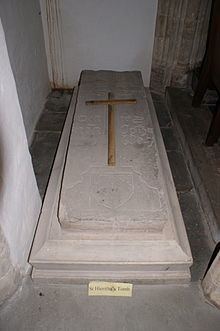Feast 8 July | ||
 | ||
Died Chittlehampton, United Kingdom | ||
Urith under the table
Urith (more properly in Welsh Iwerydd, but also known in Latin as Hieritha and occasionally corrupted to Erth), was a Brythonic maiden from the Westcountry who was martyred, possibly in the early 8th century, and subsequently revered as a saint. The name is still common in the English county of Devon. Her feast day is 8 July.
Contents
- Urith under the table
- Gatojca embelsire torte urith
- History
- The legend
- Veneration
- The Trinity College hymn
- Devonshire girls baptised Urith
- References
Gatojca embelsire torte urith
History
Urith is a fairly obscure figure. John Leland makes no mention of her, nor does Capgrave's Nova Legenda Angliae, and Nicholas Roscarock knew little of her apart from the fact of her existence. A book of her life, containing a record of her miracles, was at one time present in her shrine, and appears to be the basis of a rhyming poem in Latin now held by Trinity College, Cambridge. According to both this and William Camden, her legend was as follows:
The legend
Legend says Saint Urith was born at East Stowford in Swimbridge parish, in the English county of Devon. She was converted to Christianity by St Kea, lived as a hermit in nearby Chittlehampton, where she founded a church. At the urging of an allegedly jealous, and perhaps pagan, stepmother, some female haymakers beheaded the girl with a scythe, during a period of severe drought. When she fell to the ground, a spring of water burst from the spot and flowers, thought to be scarlet pimpernels, sprang forth wherever a drop of her blood was sprinkled. These last elements of her legend are the same as those found in the Lives of Sidwell and Juthwara. Urith was buried near the site of her martyrdom and a church was later built above her grave. A more likely version of her death suggests she was killed by invading Saxons, although if the traditional 8th century date is correct, this may, in reality, have been an early Viking raid.
Veneration
Saint Urith's holy well still stands at the east end of Chittlehampton, now called by the corrupt name of Taddy Well or Saint Teara's Well. Many of the pilgrims were sufferers of eye disease who came to anoint themselves with the holy water. There are still two stone crosses in the parish which may have been guideposts to the shrine. The exact burial place of Saint Urith was probably in the small chapel on the north side of the sanctuary of the parish church, which originally contained an image of the saint. This chapel now doubles as a passage leading to a vestry. There is reason to believe that a medieval slab there may still cover Saint Urith's body. There was a regular pilgrimage to her shrine on her feast day, 8 July, until 1539. Offerings left there were sufficient to rebuild the church tower, reputedly the finest in Devon. Even in the last year of pilgrimages, the vicar received £50 from his share of the offerings. This was three times his income from tithes and glebe. By 1540 the saint's statue had been removed from the church. The pulpit of the church, carved around 1500, survives and this depicts Urith holding a martyr's palm and the foundation stone of the church. A modern statue now stands in a niche high up on the exterior of the tower and she is also shown in a stained-glass window of the 16th century found at Nettlecombe in Somerset.
Continuing the tradition, the pilgrimage has now been revived and villagers still celebrate the legend on her feast day, with a procession to the well. The Trinity College hymn is sung by the congregation, the well is opened and water drawn from it and blessed.
The Trinity College hymn
"Sing, Chittlehampton, sing!
Let all Devon's meadows ring with Holy Gladness for our Saint's renown,
And thou,
Blest maiden pray,
that we on this our day,
May bear our cross and win our heavenly crown".
